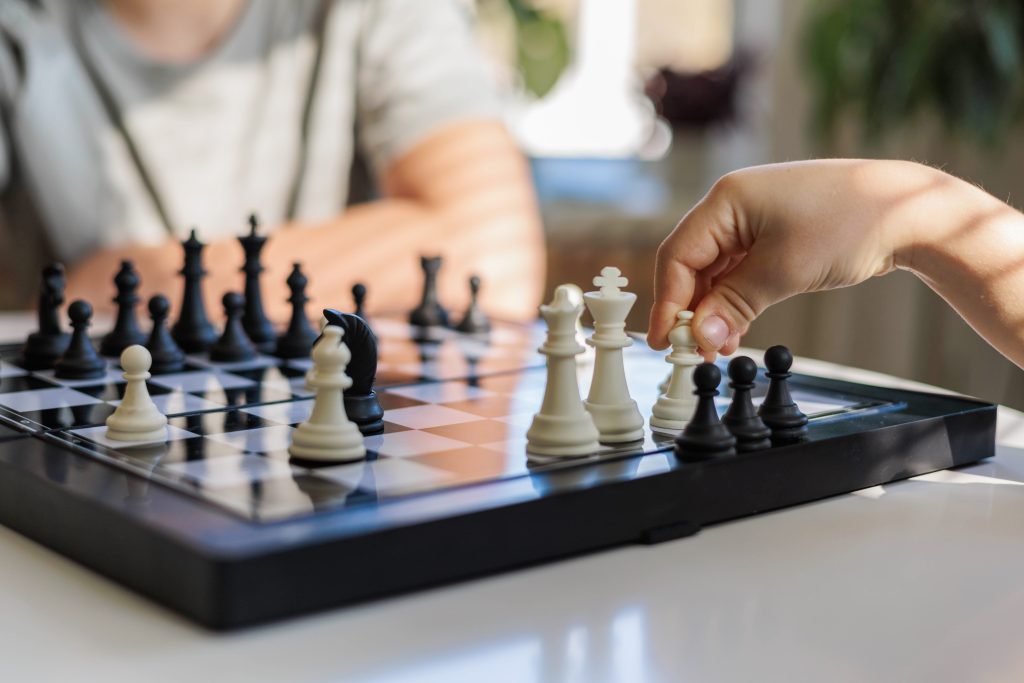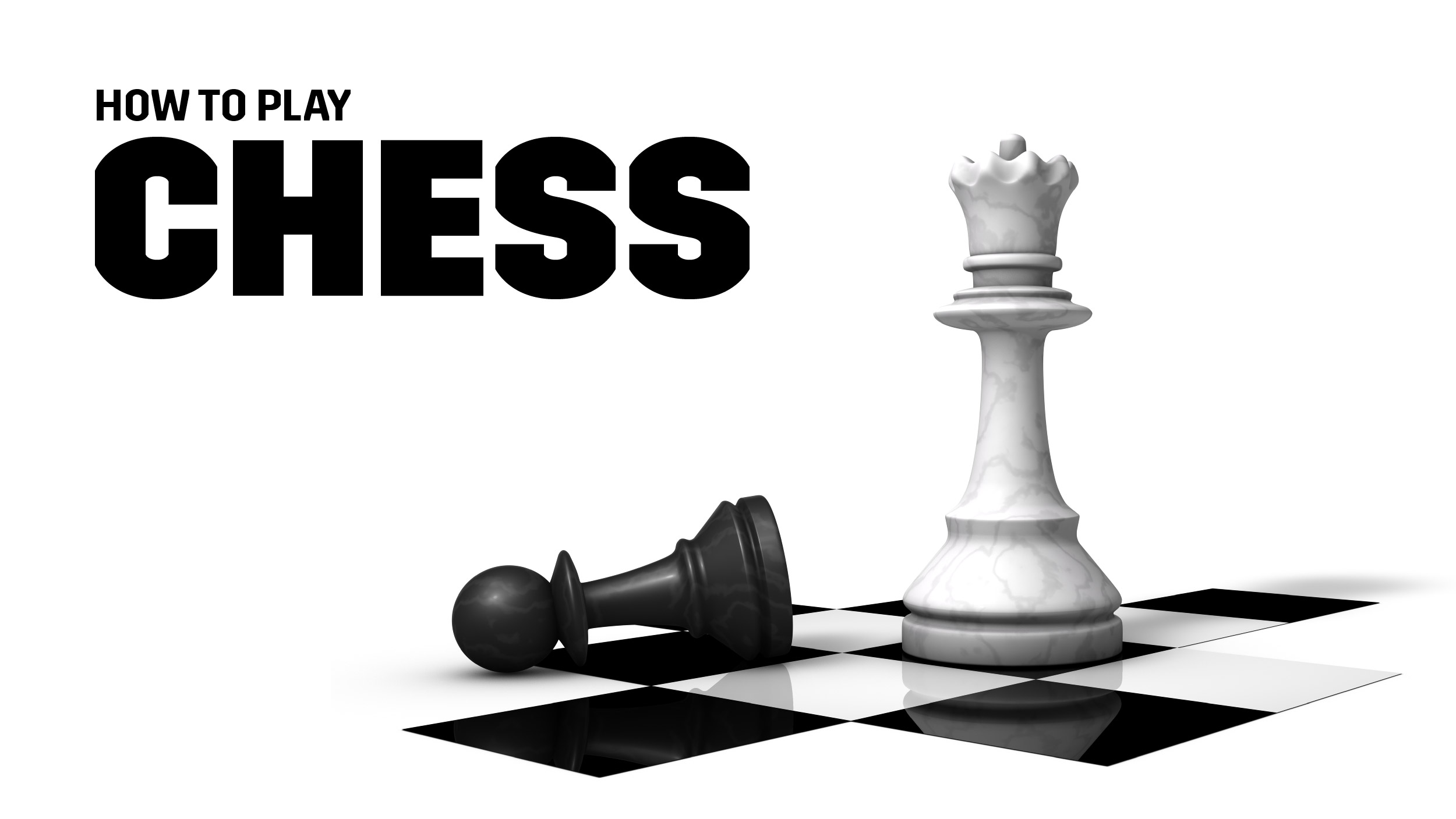Table of Contents
ToggleIf you ask your family and friends which board game they know best, the answer is likely Chess. Its universal appeal makes it one of the most-played games worldwide. Whether on a traditional board or a digital platform, Chess challenges you to think ahead, strategize, and make precise moves.
But if you don’t know how to play the game, a sense of FOMO can take over. If you are in that stage or looking for a detailed guide, you are in the right place.
This article will walk you through the basics, from rules and piece movements to what makes Chess such a fascinating game. Without further ado, let’s learn how to play chess for beginners.
Chess Rules
- The goal is to checkmate your opponent’s king as per the rules of chess.
- The game is played on an 8×8 board, with each player having 16 pieces.
- White moves first, then players take turns.
- King moves one square in any direction.
- The queen moves any number of squares in any direction.
- Rook moves in straight lines (horizontally or vertically).
- Bishop moves diagonally.
- Knight moves in an “L” shape, which is two squares in one direction and one square to the side.
- The pawn moves forward one square and captures diagonally.
- Checkmate ends the game where you trap the opponent’s King!
- The stalemate means no legal moves, but the King isn’t in check, and it’s a draw.
How to Play Chess

Source: Kostikova Natalia /shutterstock
Now, that you are familiar with the basic chess rules, let’s take a look at how to play chess!
Objective
The goal of Chess is to checkmate your opponent’s king. This happens when the king is under attack and has no legal moves to escape.
If a checkmate is achieved, the game ends, and the player delivering the checkmate wins. If no legal moves are available but the king is not in check, the game results in a stalemate (a draw).
Set up
Chess is played on an 8×8 board with alternating light and dark squares. To set it up correctly, ensure that the bottom-right square is white for both players. Each player starts with 16 pieces arranged in the two rows closest to them.
The second row is filled with eight pawns and forms a solid line in front of the other pieces. The first row is set up symmetrically for both players with the main pieces.
The rooks are placed in the corner squares, followed by the knights next to them. The bishops are positioned beside the knights.
The queen always starts with her own color. This means the white queen goes on a white square, and the black queen goes on a black square.
The king is placed next to the queen on the remaining central square. Once everything is set up, White moves first, and then you start playing chess!
Read More: Learn How to Become a Chess Grandmaster: A Step-by-Step Guide
Who makes the first move in Chess?
In Chess, White always moves first. After that, players take turns making one move at a time. This rule gives White a slight advantage since they get to set the pace of the game. Choosing which player plays White is usually decided randomly. Once the first move is made, both players focus on their strategies to outplay each other and win.
How to capture pieces?
Capturing happens when your piece moves to the same square as occupied by an opponent’s piece. The opponent’s piece is then removed from the board.
Most pieces capture by moving as they normally would but stopping on a square occupied by an opponent’s piece. For example, a rook captures by moving in straight lines, a bishop captures diagonally, and a queen captures in any direction. Pawns are an exception as they capture diagonally instead of straight ahead.
Knights are unique as well because they can jump over other pieces, making them tricky attackers. The knight, if lands on an opponent’s piece, captures it.
How to checkmate in chess & Win?
To checkmate, you must trap your opponent’s king so it is under attack and has no legal moves to escape. When the king cannot move to a safe square, capture the attacking piece, or block the attack. Once a king is check-mated, the game is over, and the attacking player wins. If no checkmate is possible, the game can end in a draw instead.
Movement of Chess Pieces
Let’s now understand how the chess pieces move as per the chess rules.
Pawn
A pawn moves forward a single square in a straight line. Pawns cannot move backward, diagonally, or horizontally.
An exception to this rule is when it’s the pawn’s very first move in the game. If a pawn is yet to make its first move, it can move two squares forward in a single move. However, both squares should be empty. If desired, the player can also decide to move the pawn to a single square.
The only occasion that allows a diagonal movement for the pawn is to capture an opponent’s pawn or any other piece. Pawns can capture an opponent’s piece that lies one square diagonally left or right. By capturing the opposing piece, the pawn moves to the position, replacing the captured piece. They cannot capture an adjacent piece on any other squares or proceed diagonally without a capture.
Rook (Castle)
The rook, often called the castle, can move any number of squares horizontally or vertically from its existing square (or rank). While it cannot pass through same-colored pieces, it can capture pieces of the opposite color by moving onto a pre-occupied space. Rooks cannot make a diagonal move for any reason whatsoever.
Knight
A knight is the sole chess piece that can pass through other pieces by ‘jumping’ over them. It captures pieces in a usual fashion by landing on a pre-occupied space featuring an opponent piece and cannot move to a square that’s already occupied by one of your own pieces. However, it can move over pieces of either color during the move.
Knights move in an L-shaped pattern: a couple of squares backward, forward, right or left, subsequently, one square vertically or horizontally, or vice versa – one square backward, forward, right or left, followed by two squares vertically or horizontally to complete the ‘L’ shape.
This implies that the knight can always move to the nearest square, not on its current row (rank), column (file), or adjacent diagonally.
The knight should move the entire L distance – it cannot move just two squares in a straight line without moving one to the side as well, for instance.
Bishop
The bishop can diagonally move any number of squares – meaning it always moves along the diagonal line of squares that matches the current color of its square. Each player starts the game with one bishop that moves on each color. A bishop cannot move vertically or horizontally for any reason. It cannot pass through pieces of the same color, and it can capture an opposing piece by moving onto its square.
Queen
The queen is essentially the most powerful piece in Chess. It can move as many squares vertically, horizontally, or diagonally. These movements ought to be made in a single straight line in a single turn. For instance, you can’t move three squares vertically followed by three spaces diagonally. As with other pieces, barring the knight, the queen cannot pass through pieces of the same color and instantly captures a piece of the opposite color by occupying its square.
King
The king moves a single square vertically, horizontally, or diagonally. The king is not permitted to move into a space that grants the opponent a check or checkmate. As an exception to every other chess piece, the king is never captured in the game – a player loses when the opponent checkmates their king, typically leading to an inescapable capture on the opponent’s next turn.
How To Draw A Chess Game?
A Chess game can end in a draw when no player can win. Here are five ways this can happen as per the rules of chess.
Stalemate
This happens when a player has no legal moves, but their king is not in check. Since they can’t move, the game ends in a draw. For example, if Black’s king has no safe moves and no other piece to move, but it’s not in check, it’s a stalemate.
Mutual Agreement
Players can agree to a draw if they feel neither side has a winning chance. This often happens when both sides have equal material and no clear way to checkmate.
Insufficient Material
If neither player has enough pieces to checkmate, the game is a draw. For example, a king and a bishop vs. a king is not enough to force a checkmate.
Threefold Repetition
If the same position happens three times, not necessarily in a row, a player can claim a draw. This prevents endless repetition.
50-Move Rule
If 50 moves pass without a pawn move or a capture, the game is drawn. This prevents games from dragging on forever.
What is Castling in Chess?
Castling is a concept that works only when a player’s king and a rook are yet to move during the game. You can perform casting with either rook, provided they’re yet to move from their original corner positions.
Castling involves moving the king piece a couple of squares towards the rook with which it is castling before moving the rook to the unoccupied square that the king passed ‘through.’ This practically places the rook adjacent to the king’s other side. In contrast, the king moves two squares toward the space where the rook was in place initially. Whether castling is done kingside or queenside, the king effectively moves only two spaces.
You cannot use the king in a Castling maneuver if it is in check. But you can use a rook in castling even if it is under threat from an opponent’s piece – in other words – if it could be captured on the opponent’s following turn or on any of the squares it passes through while making the move.
A player cannot castle if it puts the king into check. It is also impossible when there are pieces between the king and the rook – the squares in between need to be clear.
What is En Passant?
En passant stands for ‘in passing’ in French. It is one of the most well-known chess moves, occurring when a pawn moves two squares forward as its optional starting position.
If an opponent’s pawn can legally capture the moving pawn if it moves one square instead of two, the opponent may declare en passant on their subsequent turn and diagonally move their pawn onto the square that the pawn passes through – capturing it as if it moved just one square. En passant must be declared as the opponent’s following turn to be legal – otherwise, the player loses the opportunity to capture the pawn.
Pawn Promotion
If any pawn reaches the other end of the board, i.e., the farthest row (rank) from your perspective – you can promote it to another piece: a knight, bishop, rook, or queen. The new piece immediately replaces the pawn on its current square and follows the rules of the promoted piece.
Many casual players use already captured pieces to stand for the promoted pieces, but you can legally promote a pawn to any piece, whether it’s captured or not. For instance, a player can have several queens due to pawn promotion. There is no restriction on the number of pawns you can promote.
Read More: Understand the Difference Between Tactical vs. Positional Chess in Online Games
How to play with Chess Tournament Rules?
Let’s understand how to play chess board games as per the tournament play.
Remember, chess tournaments have special rules that might not apply when playing at home or online. However, it’s good to know them!
One important rule is touch-move. If you touch one of your own pieces, you must move it if it has a legal move. If you touch an opponent’s piece, you must capture it if possible. If you just want to adjust a piece, you have to say “adjust” first before touching it.
Tournaments also use timers. This is done to keep games fair. Each player gets a total time limit for the whole game. After making a move, a player presses a button to start the opponent’s clock and then the opponent moves. If a player runs out of time, they lose. This is unless the opponent doesn’t have enough pieces to checkmate, in which case it’s a draw.
These rules keep the game organized and competitive.
Basic Chess Strategies
Now that you know how to play chess board game. Let’s unpack the basic strategies that can amp up your game.
Don’t Waste Away Your Chess Pieces
Every piece on your side of the board holds value. So don’t lose them carelessly. Instead, you need pieces to checkmate and win, so think before making a move. In fact, chess players use a simple point system to understand the value of each piece. This is especially crucial to learn if are just starting out and learning how to play chess for beginners.
- Pawn = 1
- Knight = 3
- Bishop = 3
- Rook = 5
- Queen = 9
- King = priceless!
These points help you decide whether to capture or trade pieces. For example, trading a knight for a queen is a great deal! However, these points don’t decide the winner, but just help you make wise choices during the game.
Keep Your King Safe
Your king is the most important piece, so keeping him safe should be a top priority! The best way to do this is to castle early, which moves your king toward the corner where he is usually safer. If you wait too long, your king could be exposed to attacks.
Even if you are close to winning, it won’t matter if your own king gets check-mated first. So, always think about defense while attacking. A well-protected king makes it harder for your opponent to checkmate you. This gives you a better chance to win the game. That’s why always be aware of the opponent’s moves!
Use All of Your Chess Pieces
Don’t leave your pieces sitting on the back row. Instead, get them into the game! The more pieces you use, the stronger your attacks will be. If you only rely on one or two pieces, a good opponent will easily defend against you.
Try to develop all your pieces early in the game. Move your knights and bishops out, castle your king, and get your rooks and queen ready for action. The more pieces you have working together, the better your chances of attacking and winning.
Control the Center of the Chessboard
The center of the board is the most important area in Chess. If you control it with your pieces and pawns, you will have more space to move and stronger attacks. It also makes it harder for your opponent to place their pieces well.
At the start of the game, try to move your pawns to the center, like e4 or d4, and develop your knights and bishops toward the middle.
Avoid unnecessary side moves and keep your focus on controlling the center. A strong center gives you better positioning and a higher chance of winning.
How to Play Chess Variants?
Here are a few chess variants that can add more excitement to the game. So, how to play chess variants? Let’s take a look!
Chess960
Chess960 is also called Fischer Random Chess and brings a fun twist to regular Chess. Here, the pawns stay in their normal spots, but the back-row pieces (king, queen, bishops, knights, and rooks) are shuffled into a random starting position. The only rule is that the king must be between the rooks, so castling is still possible.
This version makes the game more creative because you can’t rely on memorized openings. You have to think on the spot! Every game starts differently, so it’s a great way to improve your skills.
King of the Hill
King of the Hill is a fun Chess variation where the goal isn’t just to checkmate, but it’s getting your king to the center of the board, i.e., d4, d5, e4, or e5. If you reach one of these squares safely, you win instantly!
You still play by normal Chess rules, but now you have two ways to win, which include checkmate or getting your king to the “top of the hill.” This adds a new layer of strategy because you and your opponent must fight for control of the center while also watching for checkmate threats.
Bughouse
Bughouse is a Chess game played in teams of two. When you capture a piece, your teammate gets that piece and can place it anywhere on their board.
For example, if you take your opponent’s knight, your teammate can drop that knight onto their board and use it right away. Since pieces keep coming back, the game is super involved and full of surprises.
Crazyhouse
Crazyhouse is a wild version of Chess where captured pieces switch sides and become yours. If you are playing as White and capture a Black pawn, that pawn turns into a White pawn that you can place anywhere on the board on a future turn. Instead of moving a piece, you can drop a captured piece back into play.
3-Check
3-Check Chess is a simple but exciting version of Chess where checkmating isn’t the only way to win. If you check your opponent’s king three times, you win instantly, even if the king is still safe! This means you have to be extra careful about letting your king get checked.
Read More: List of the Best Free Chess Apps and Chess Apps for Real Money!
FAQs
Who makes the first move in Chess?
As per the International Chess Federation’s (FIDE) rules, the player with the white pieces initiates the first move. Then, the players alternately take turns.
Does age affect Chess?
Numerous players see their chess ratings go lower as they age. Chess experts also believe that the top chess players peak during ages 35 – 40. However, since Chess combines cognitive ability with the accumulation of vast chess knowledge, there can also be occasional contradictions.
How long does it take to learn Chess?
We don’t have a clear-cut answer to this as it entirely depends on the amount of time a person dedicates to learning and playing Chess. Chess isn’t the most complicated game to learn, and you can pick it up pretty quickly. On average, around 1-3 years of practicing can bring out the ultimate chess technician in you!
What are the basic rules of chess?
Chess is a two-player game where each player moves one piece per turn. The goal is to checkmate the opponent’s king. Each piece moves differently, and strategy is key. We bring the complete information for you in the above blog. Take a look!
How to play chess as a beginner?
You can start by learning how each piece moves and grasp all the chess rules thoroughly. Apply the necessary strategies and practice regularly. You can also learn a lot from watching Grandmasters play.
Is chess a skill or luck?
Chess is 100% skill. There’s no luck involved. Success depends on strategy, planning, and experience. The more you practice and learn, the better you get at winning!








